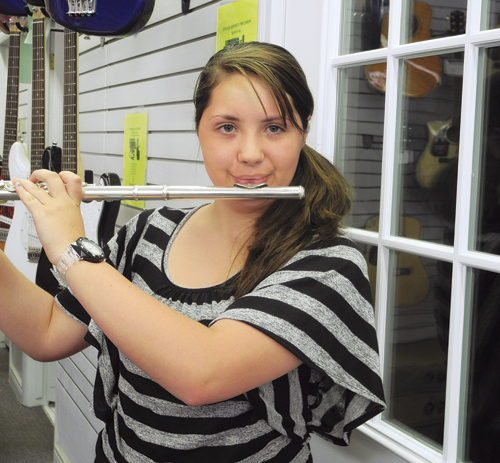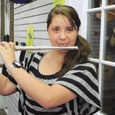
Flutists sometimes fall into behaviors which are less than completely rational. They lick their lips while simultaneously trying to inhale, stand stiff are a board while struggling to take deep breaths, dance while playing, wave the flute like a baton, or wait until the last second to breath before a long phrase. With each new group of students I see the same unfortunate instincts recur, including the desire to raise the tongue in the high register, to smile while playing, and to blow with a too-slow airstream in the low register.
It can be frustrating for teachers to see the same problem habits in student after student. A closer look reveals that even if some of these behaviors are less than perfectly suited to achieving fine flute playing, not everything students do wrong is irrational. A fair percentage of these bad behaviors actually accomplish something important. Figuring out why students are doing something less than ideal is the first step to showing them better ways to create the desired result.
Self-awareness
A first step is to become more physically aware of how the body works and how to use it. While completing my doctoral degree at The Juilliard School, I took an Alexander Technique class that helped me become more deeply aware of how I use my body. After each Alexander session, I would find myself sitting in my next class, heavily influenced by Alexander Technique practice, releasing tension in my left foot, wondering why my elbow stiffened when writing with a pen, or why I clenched my jaw or bunched up my tongue for no apparent reason. Becoming more self-aware physically helped me relax in my life and as a flutist. It also taught me that my first instinct in doing something might not be the best choice.
Controlling the Airspeed
As a young, less experienced teacher, I was perplexed why year after year new students arrived with the same bad physical habits. One of the most ubiquitous is raising the tongue inside the mouth, especially when playing in the high register. This clearly leads to a tight and shrill, less resonant sound. Before fixing the problem, it is helpful to consider why so many students adopt this method of playing.
In order to get the flute high register to speak, the airstream must be sufficiently fast. When students begin playing the flute, they blow hard to get the high register to pop out. This is a legitimate solution, but often not the best one. Students eventually realize that they need to be able to produce a fast airstream without blowing as hard as they can.
Many flute teachers compare how air travels through the aperture with the way water moves through the nozzle of a hose. In this analogy, the embouchure is shaped to guide the air as the nozzle directs the water. If the nozzle is relatively open, the water will dribble down to the ground. However, if the nozzle is tightened, the water is forced to move much more quickly. This is because the same amount of water goes through a smaller opening. For the high register to speak well and in tune at a variety of dynamics, the aperture is made smaller.
While making the aperture smaller is the ideal, another less efficient way to increase air speed is raising the tongue inside of the mouth. This is quite a bit more practical and efficient than perpetually blowing as hard as possible, and is what almost all young flutists fall back on instinctively.
Returning to the analogy of water coming through a hose, raising the tongue in the mouth is similar to squeezing the hose near the nozzle. While this would have the effect of forcing the water to go through a smaller passageway more quickly, it is clearly more efficient to adjust the nozzle instead.
For this analogy to work, there must be a good and steady supply of water through the hose or in the case of a flutist, a reliable and constant supply of air. The hose is attached to a faucet that provides a steady source of water, and flutists should provide a solid foundation of support that will lead to a constant airstream. Many students, especially the young or more timid ones, narrow the space in the mouth and throat because they are not supporting and blowing sufficient amounts of air in the first place. Narrowing the channel through which the airstream passes allows students to support and blow less yet still produce the air speed required to create a flute tone. Tightening in the tongue, mouth and throat is never a good means of creating faster air speed. It is certainly not acceptable as a form of support and will cost players abundantly in terms of resonance and beauty of sound.
Observation
I have learned that it is much simpler to convince students to change bad habits when they understand why they are tempted towards those habits in the first place. If students understand that the tongue is raised or the throat is tightened because the necessary air speed results, they can then intelligently look for alternative solutions to the problem of air speed while beginning to let go of the bad habit. When teachers instead simply tell students to lower the tongue and open the oral cavity, students struggle more to do so. The body subconsciously understands the need for air speed and remembers how it has (less desirably) created air speed in the past. With a better understanding of why students are doing something, it is easier to find alternate, preferable means to accomplish this subconscious goal of creating a fast-enough airstream to produce a good flute tone, especially in the high register.
Smiley Embouchure
Other bad habits can be explained by a student’s need to accomplish something essential to flute playing. The problem of smiling while blowing often comes from a subconscious effort to control the airstream.
When flutists with a smiley embouchure are only told to “relax the corners of the mouth,” they instantly feel a loss of control and want to return to the previous, familiar and comfortable smiling embouchure. Instead, try explaining to students that this feeling of control can be maintained by bringing the corners of the lips forward (“say ooh”). Students soon realize that control of the airstream is retained while more flexibility is gained. This also tends to lead them to relax automatically. They learn to trust that the new, less tight, and less spread embouchure can in fact aim the air more accurately.
Low Register
Flutists learn early on to create the low register by blowing with a gentler airstream. In flute playing, the air column must angle more sharply downward to create low-register notes. Students intuitively realize that the air angles down when they do not blow as hard. Returning to the hose analogy, when the faucet is adjusted to let less water flow through the hose, the water coming out of the hose angles more towards the ground. If flutists blow less air, the airstream angles down more sharply, and the low register speaks better.
Of course, young flute students usually do not think about the reasons behind how hard or gently they decide to blow. They instinctively respond to their bodies’ feedback and realize that it is easier to make the low register speak by angling the airstream more sharply down into the flute. An insightful teacher can help students understand that air angle does not need to be connected to air speed. One can play in the flute’s low register with as much air speed as one desires, getting a full tone, better resonance, and better projection, as long as the air is correctly angled down into the flute. Once students have this epiphany, they can aim the airstream towards the elbow or any other envisioned point, training the embouchure rather than decreasing air speed.
Students display these and other problematic habits in an effort to make the flute respond. Understanding the instincts that create these bad habits will help teachers explain to students how to accomplish the same goals through better means.






